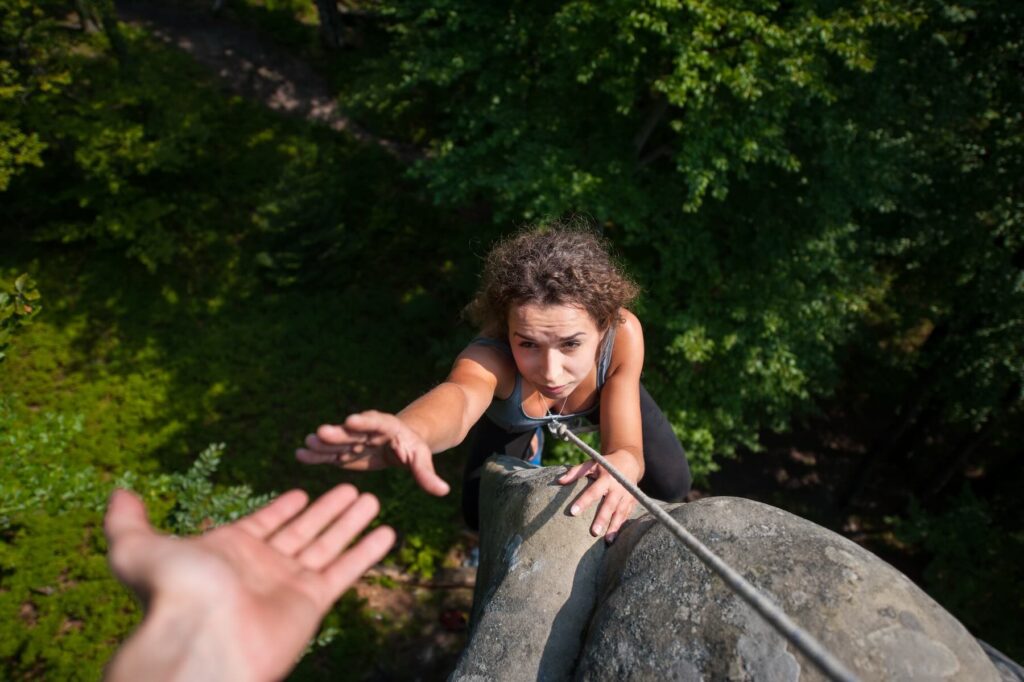How to Be Brave: Practical Steps to Overcome Fear and Anxiety

At the Foundation for Developing Compassion and Wisdom (FDCW), we have been exploring the Seven Foundations for Happiness and Peace, as articulated by Lama Zopa Rinpoche. Each month, we have been focussing on a different foundation, offering insights and practical advice to help you nurture these essential qualities. This month, our focus is on the final foundation of Courage and how to be brave by overcoming fear and anxiety.
“Courage is resistance to fear, mastery of fear—not absence of fear.”
—Mark Twain
Bravery is deeply connected to courage—the inner strength that allows us to face fear and anxiety head-on. It is not about the absence of fear but the ability to move forward despite it, relying on resilience and determination. Fear, anxiety, and stress are natural responses, yet they often hold us back from reaching our full potential. By understanding and addressing these patterns, we can learn to cultivate courage and step into a braver version of ourselves.
In this article, we’ll explore actionable advice to help you confidently face everyday challenges. Whether it’s making difficult decisions or embracing new opportunities, these steps will empower you to navigate life with greater courage and less fear.
What Does it Mean to be Brave?
Bravery is often portrayed as grand, fearless acts, but in reality, it is much more nuanced. True bravery isn’t about the absence of fear—it’s about taking action even when fear is present. It’s the quiet resolve to step forward, knowing that the outcome is uncertain, and the strength to persevere when challenges seem insurmountable.
In everyday life, bravery can take many forms. It might be speaking up in a meeting or standing firm on a difficult decision. It could mean trying something entirely new, like starting a hobby or travelling alone, even when self-doubt creeps in. For others, bravery is facing personal struggles, such as seeking help for mental health, overcoming a phobia, or making amends in a strained relationship.
Each act of bravery, no matter how small, contributes to building resilience and confidence. By redefining bravery as the ability to act in the presence of fear, we make it an accessible, empowering quality that can enrich all aspects of life.

Recognising Patterns that Inhibit Bravery
Bravery often feels out of reach because of emotional patterns that hold us back. Fear, self-doubt, anxiety, and stress are common barriers that inhibit courageous action. These emotions can manifest in various ways: a racing heart, a spiral of negative thoughts, or even physical avoidance of challenging situations. While these feelings are natural, they can cloud our judgement and make us second-guess ourselves, ultimately keeping us stuck in our comfort zones.
For example, fear of failure might stop us from trying something new, while self-doubt can lead to silence when we need to speak up. Anxiety creates scenarios in our minds that often feel far worse than reality, and chronic stress can make even simple decisions feel overwhelming. Together, these inhibitors can prevent us from taking meaningful steps forward.
This is where self-awareness becomes essential. By identifying the thoughts and feelings that arise when we face fear, we can begin to understand our emotional triggers. Recognising these patterns allows us to challenge them, replacing reactive behaviours with deliberate choices. Self-awareness is the foundation for developing courage, helping us to pause, reflect, and act with intention rather than fear.
Strategies for Building Bravery
Building bravery is a gradual process, and small, intentional steps can help cultivate courage over time. Here are three practical strategies to support you in overcoming fear and anxiety:
1. Mindfulness Practices
Mindfulness is a powerful tool for managing fear and anxiety, creating space to act bravely. Breathing exercises, such as deep breaths or the 4-7-8 technique (inhale for 4 seconds, hold for 7, exhale for 8), can quickly calm the nervous system. Visualisation is another effective method: picture yourself successfully navigating a challenging situation, focusing on the positive outcome. Grounding techniques, like feeling the texture of an object in your hand or focusing on the sensations of your feet touching the ground, can help anchor you in the present moment, reducing overwhelming thoughts.
2. Breaking Challenges into Steps
Big challenges can feel daunting, but breaking them into smaller, manageable steps makes them less intimidating. Start with one small action that moves you closer to your goal. For example, if you’re afraid of public speaking, begin by practising in front of a friend or recording yourself. Each small step builds confidence and reduces fear, proving to yourself that bravery is within reach.
3. Reframing Failure
Fear of failure often holds people back from being brave. Reframing failure as a natural part of growth can help shift your perspective. Every setback is an opportunity to learn, adjust, and improve. For instance, a failed job interview isn’t the end—it’s a chance to refine your skills and better prepare for the next opportunity. By embracing failure as a stepping stone rather than a defeat, you open the door to greater courage and resilience.
Each of these strategies can empower you to face challenges with confidence, cultivating a sense of bravery that becomes second nature over time.

Building Daily Habits for Bravery
Bravery is not just about big moments—it’s a practice that grows from consistent daily habits. By integrating small, intentional actions into your routine, you can cultivate a courageous mindset.
1. Journaling About Small Acts of Courage
Take a few moments each day to reflect on and write about small acts of bravery. Whether it was speaking up in a meeting, trying something new, or facing a difficult situation, acknowledging these moments reinforces your ability to be brave. Over time, journaling helps you notice patterns of courage and reminds you of your progress, building confidence for future challenges.
2. Practising Gratitude to Counterbalance Fear
Gratitude has a grounding effect that shifts focus from fear to positivity. By appreciating what’s going well in your life, you create a more resilient mindset. Each day, list three things you’re grateful for, no matter how small. Gratitude fosters a sense of abundance and optimism, making it easier to approach life’s challenges with courage.
3. Surrounding Yourself with Supportive People
The people around us play a significant role in shaping our mindset. Seek out friends, mentors, or communities that encourage and celebrate bravery. Whether it’s sharing your goals, receiving constructive feedback, or simply feeling supported, these relationships provide the encouragement needed to take bold steps.
These simple yet powerful habits create a foundation for bravery in your everyday life, helping you face challenges with greater confidence and resilience.
Facing Bigger Challenges with Bravery
While daily acts of bravery build a strong foundation, life’s bigger challenges often demand deeper reserves of courage. Facing these moments with bravery requires preparation, resilience, and inspiration.
1. Preparing Mentally for High-Stress Situations
Before confronting a major challenge in your professional life, mental preparation is key. Visualisation techniques can help you imagine the situation going well, which boosts confidence. Additionally, practising positive affirmations like “I am capable of handling this” can steady your resolve. Taking a few calming breaths or engaging in mindfulness just before the challenge can also reduce stress and keep you focused on the task at hand.
2. Resilience and Perseverance: Staying Brave
Bravery during significant challenges often requires resilience—the ability to bounce back from setbacks—and perseverance, the determination to keep going despite obstacles. These qualities are like muscles, strengthened by each trial you face. For example, if you’re tackling a long-term goal like pursuing a degree or recovering from a personal loss, remind yourself of the progress you’ve already made. Breaking the challenge into smaller steps and celebrating milestones can keep you motivated and courageous.
3. True Stories of Transformative Bravery
Real-life stories of acts of courage inspire us to face our own challenges in our daily lives. Consider the inspiring story of Malala Yousafzai, who overcame unimaginable adversity with bravery to advocate for girls’ education worldwide. Her courage in the face of danger demonstrates how staying true to one’s values can transform fear into strength. On a personal level, bravery can be seen in everyday heroes—such as a friend standing up against injustice or someone rebuilding their life after a setback.
These stories remind us that bravery is not only about extraordinary acts but also about persevering through difficulties with integrity and determination. By preparing mentally, cultivating resilience, and drawing inspiration from others, we can rise to meet life’s biggest challenges with courage.

Becoming Brave, One Step at a Time
Bravery is not an innate trait reserved for a select few—it is a skill anyone can cultivate. By understanding the nature of fear and anxiety, recognising patterns that hold us back, and practising strategies to build courage, we can all learn to face life’s challenges with greater confidence and resilience.
Remember, bravery begins with small steps. Each time you speak up, try something new, or confront a personal fear, you are strengthening your ability to be courageous. Over time, these small acts build into a foundation that empowers you to tackle even the biggest challenges.
As you embark on your journey to cultivate bravery, keep in mind these inspiring words:
“You gain strength, courage, and confidence by every experience in which you really stop to look fear in the face. You are able to say to yourself, ‘I have lived through this horror. I can take the next thing that comes along.’ You must do the thing you think you cannot do.”
—Eleanor Roosevelt
Bravery isn’t about being fearless—it’s about acting in spite of the presence of fear and discovering the incredible strength you hold within. Start small, stay consistent, and watch as your courage grows, one step at a time.

Foundation for Developing Compassion and Wisdom (FDCW)
At FDCW we are committed to a more compassionate, wiser world. We provide resources, courses and training to develop qualities such as kindness, patience and honesty – qualities which are essential for meeting the challenges of the world we all share.
The Foundation for Developing Compassion and Wisdom (FDCW) was established as a global charity based in London in 2005. Since then we have provided secular training, programmes and resources across many sectors of society – schools, universities, hospices, workplaces, healthcare, youth groups and community centres. Our courses have reached thousands of people across the world through our dedicated and growing network of facilitators in more than 20 countries.
Support our Work
As a non-profit organization, FDCW relies on donations like yours to continue producing valuable resources and hosting events. You can support us by sharing our newsletter, following us on social media, and making a donation. Every contribution, big or small, helps us in our efforts and we truly appreciate it.






